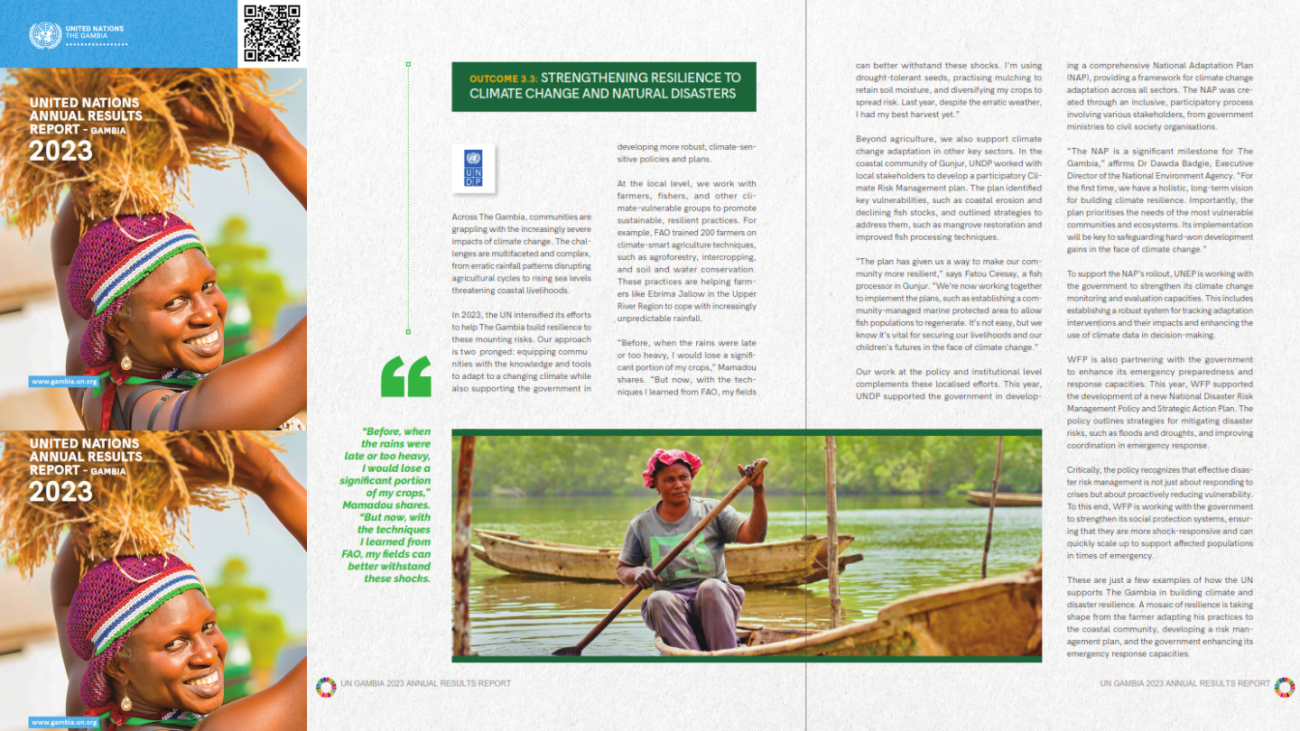Across The Gambia, communities are grappling with the increasingly severe impacts of climate change. The challenges are multifaceted and complex, from erratic rainfall patterns disrupting agricultural cycles to rising sea levels threatening coastal livelihoods.
In 2023, the UN intensified its efforts to help The Gambia build resilience to these mounting risks. Our approach is two-pronged: equipping communities with the knowledge and tools to adapt to a changing climate while also supporting the government in developing more robust, climate-sensitive policies and plans.
At the local level, we work with farmers, fishers, and other climate-vulnerable groups to promote sustainable, resilient practices. For example, FAO trained 200 farmers on climate-smart agriculture techniques, such as agroforestry, intercropping, and soil and water conservation. These practices are helping farmers like Ebrima Jallow in the Upper River Region to cope with increasingly unpredictable rainfall.
“Before, when the rains were late or too heavy, I would lose a significant portion of my crops,” Mamadou shares. “But now, with the techniques I learned from FAO, my fields can better withstand these shocks. I’m using drought-tolerant seeds, practising mulching to retain soil moisture, and diversifying my crops to spread risk. Last year, despite the erratic weather, I had my best harvest yet.”
Beyond agriculture, we also support climate change adaptation in other key sectors. In the coastal community of Gunjur, UNDP worked with local stakeholders to develop a participatory Climate Risk Management plan. The plan identified key vulnerabilities, such as coastal erosion and declining fish stocks, and outlined strategies to address them, such as mangrove restoration and improved fish processing techniques.
“The plan has given us a way to make our community more resilient,” says Fatou Ceesay, a fish processor in Gunjur. “We’re now working together to implement the plans, such as establishing a community-managed marine protected area to allow fish populations to regenerate. It’s not easy, but we know it’s vital for securing our livelihoods and our children’s futures in the face of climate change.”
Our work at the policy and institutional level complements these localised efforts. This year, UNDP supported the government in developing a comprehensive National Adaptation Plan (NAP), providing a framework for climate change adaptation across all sectors. The NAP was created through an inclusive, participatory process involving various stakeholders, from government ministries to civil society organizations.
“The NAP is a significant milestone for The Gambia,” affirms Dr. Dawda Badgie, Executive Director of the National Environment Agency. “For the first time, we have a holistic, long-term vision for building climate resilience. It unites the efforts of government, civil society, and local communities in addressing the impacts of climate change. Its implementation will be key to safeguarding hard-won development gains in the face of climate change.”
To support the NAP’s rollout, UNEP is working with the government to strengthen its climate change monitoring and evaluation capacities. This includes establishing a robust system for tracking adaptation interventions and their impacts and enhancing the government’s ability to make evidence-based decisions.
WFP is also partnering with the government to enhance disaster risk preparedness and response capacities. This year, WFP supported the government in finalizing its National Disaster Risk Management Policy and Strategic Action Plan. The policy outlines strategies for mitigating disaster risks, such as floods and droughts, and improving coordination in emergency response.
Critically, the policy recognizes that effective disaster risk management is not just about responding to threats but proactively reducing vulnerabilities. To this end, WFP is working with the government to implement a social protection system ensuring that they are more shock-responsive and can quickly scale up to support affected populations in times of emergency.
These are just a few examples of how the UN supports The Gambia in building climate and disaster resilience. A mosaic of resilience is taking shape from farmers adapting their practices to the coastal community, developing a risk management plan, to the government enhancing its emergency response capacities.



